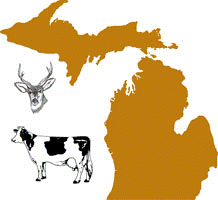Wildlife Disease and Zoonotics
Date of this Version
2005
Abstract
Bovine tuberculosis (Mycobacterium bovis) was discovered in northern Michigan white-tailed deer (Odocoileus virginianus) in 1994, and has been known to exist in Michigan cattle herds since 1998. Despite efforts to eradicate the disease in cattle, infection and re-infection of farms continues to occur, suggesting transmission among cattle, deer, or other wildlife reservoirs. The goals of this study were to document wildlife activity on farms and evaluate the possible role wildlife play in the ecology of bovine tuberculosis (TB) in Michigan. Visual observations were conducted on farms in a 5-county area of northern Michigan to document direct wildlife-cattle interactions (i.e., <5 m between individuals) and indirect interactions (e.g., wildlife visitations to food stores and areas accessible to cattle). Observations were conducted primarily during evening and early morning hours between January and August, 2002, and on a 24-hour schedule between January and August, 2003. Total observation time accumulated through the duration of the study was 1,780 hours. Results indicated that direct interaction between deer and cattle was a rare event; no direct interactions were observed during the first year, and only one direct interaction was observed during the second year. However, through the duration of the study 21 direct interactions were documented between cattle and turkey, and 11 direct interactions were documented between cattle and mammals other than deer. In total, 273 indirect interactions by deer, 112 indirect interactions by turkeys, and 248 indirect interactions by mammals other than deer were observed during the 2 field seasons combined. These data supported the hypothesis that indirect interactions among wildlife and cattle are a potential mechanism for the transmission of TB in Michigan. If direct interactions were important mechanisms of TB transmission to cattle in northern Michigan, my data suggested that feral cats were the species of most concern, even though there were more observations between turkey and cattle. Unlike cats, which can become infected with and transmit TB, there is no evidence for such pathogenesis in turkey.



Comments
A thesis submitted in partial fulfillment of the requirements for the degree of Master of Science in Wildlife Science.